Timoshenko beam theory
The Timoshenko beam theory was developed by Russian scientist and engineer of Ukrainian ethnicity Stephen Timoshenko early in the 20th century.[1][2] The model takes into account shear deformation and rotational inertia effects, making it suitable for describing the behaviour of short beams, sandwich composite beams or beams subject to high-frequency excitation when the wavelength approaches the thickness of the beam. The resulting equation is of 4th order, but unlike ordinary beam theory - i.e. Euler–Bernoulli beam theory - there is also a second order partial derivative present. Physically, taking into account the added mechanisms of deformation effectively lowers the stiffness of the beam, while the result is a larger deflection under a static load and lower predicted eigenfrequencies for a given set of boundary conditions. The latter effect is more noticeable for higher frequencies as the wavelength becomes shorter, and thus the distance between opposing shear forces decreases.
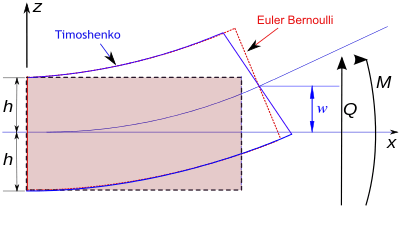
If the shear modulus of the beam material approaches infinity - and thus the beam becomes rigid in shear - and if rotational inertia effects are neglected, Timoshenko beam theory converges towards ordinary beam theory.
Quasistatic Timoshenko beam
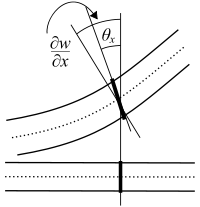
 which is not equal to
which is not equal to  .
.In static Timoshenko beam theory without axial effects, the displacements of the beam are assumed to be given by
where  are the coordinates of a point in the beam,
are the coordinates of a point in the beam,  are the components of the displacement vector in the three coordinate directions,
are the components of the displacement vector in the three coordinate directions,  is the angle of rotation of the normal to the mid-surface of the beam, and
is the angle of rotation of the normal to the mid-surface of the beam, and  is the displacement of the mid-surface in the
is the displacement of the mid-surface in the  -direction.
-direction.
The governing equations are the following uncoupled system of ordinary differential equations:
The Timoshenko beam theory for the static case is equivalent to the Euler-Bernoulli theory when the last term above is neglected, an approximation that is valid when
where
-
 is the length of the beam.
is the length of the beam. -
 is the cross section area.
is the cross section area. -
 is the elastic modulus.
is the elastic modulus. -
 is the shear modulus.
is the shear modulus. -
 is the second moment of area.
is the second moment of area. -
 , called the Timoshenko shear coefficient, depends on the geometry. Normally,
, called the Timoshenko shear coefficient, depends on the geometry. Normally,  for a rectangular section.
for a rectangular section.
Combining the two equations gives, for a homogeneous beam of constant cross-section,
The bending moment  and the shear force
and the shear force  in the beam are related to the displacement
in the beam are related to the displacement  and the rotation
and the rotation  . These relations, for a linear elastic Timoshenko beam, are:
. These relations, for a linear elastic Timoshenko beam, are:
Derivation of quasistatic Timoshenko beam equations From the kinematic assumptions for a Timoshenko beam, the displacements of the beam are given by Then, from the strain-displacement relations for small strains, the non-zero strains based on the Timoshenko assumptions are
Since the actual shear strain in the beam is not constant over the cross section we introduce a correction factor
 such that
such thatThe variation in the internal energy of the beam is
Define
Then
Integration by parts, and noting that because of the boundary conditions the variations are zero at the ends of the beam, leads to
The variation in the external work done on the beam by a transverse load
 per unit length is
per unit length isThen, for a quasistatic beam, the principle of virtual work gives
The governing equations for the beam are, from the fundamental theorem of variational calculus,
For a linear elastic beam
Therefore the governing equations for the beam may be expressed as
Combining the two equations together gives
Boundary conditions
The two equations that describe the deformation of a Timoshenko beam have to be augmented with boundary conditions if they are to be solved. Four boundary conditions are needed for the problem to be well-posed. Typical boundary conditions are:
- Simply supported beams: The displacement
 is zero at the locations of the two supports. The bending moment
is zero at the locations of the two supports. The bending moment  applied to the beam also has to be specified. The rotation
applied to the beam also has to be specified. The rotation  and the transverse shear force
and the transverse shear force  are not specified.
are not specified. - Clamped beams: The displacement
 and the rotation
and the rotation  are specified to be zero at the clamped end. If one end is free, shear force
are specified to be zero at the clamped end. If one end is free, shear force  and bending moment
and bending moment  have to be specified at that end.
have to be specified at that end.
Example: Cantilever beam
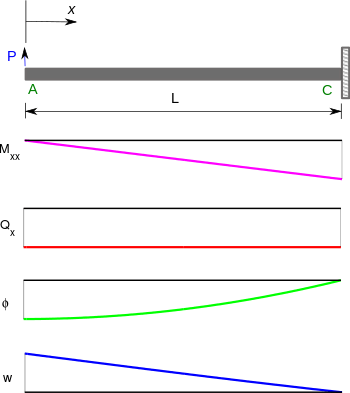
For a cantilever beam, one boundary is clamped while the other is free. Let us use a right handed coordinate system where the  direction is positive towards right and the
direction is positive towards right and the  direction is positive upward. Following normal convention, we assume that positive forces act in the positive directions of the
direction is positive upward. Following normal convention, we assume that positive forces act in the positive directions of the  and
and  axes and positive moments act in the clockwise direction. We also assume that the sign convention of the stress resultants (
axes and positive moments act in the clockwise direction. We also assume that the sign convention of the stress resultants ( and
and  ) is such that positive bending moments compress the material at the bottom of the beam (lower
) is such that positive bending moments compress the material at the bottom of the beam (lower  coordinates) and positive shear forces rotate the beam in a counterclockwise direction.
coordinates) and positive shear forces rotate the beam in a counterclockwise direction.
Let us assume that the clamped end is at  and the free end is at
and the free end is at  . If a point load
. If a point load  is applied to the free end in the positive
is applied to the free end in the positive  direction, a free body diagram of the beam gives us
direction, a free body diagram of the beam gives us
and
Therefore, from the expressions for the bending moment and shear force, we have
Integration of the first equation, and application of the boundary condition  at
at  , leads to
, leads to
The second equation can then be written as
Integration and application of the boundary condition  at
at  gives
gives
The axial stress is given by
Dynamic Timoshenko beam
In Timoshenko beam theory without axial effects, the displacements of the beam are assumed to be given by
where  are the coordinates of a point in the beam,
are the coordinates of a point in the beam,  are the components of the displacement vector in the three coordinate directions,
are the components of the displacement vector in the three coordinate directions,  is the angle of rotation of the normal to the mid-surface of the beam, and
is the angle of rotation of the normal to the mid-surface of the beam, and  is the displacement of the mid-surface in the
is the displacement of the mid-surface in the  -direction.
-direction.
Starting from the above assumption, the Timoshenko beam theory, allowing for vibrations, may be described with the coupled linear partial differential equations:[3]
where the dependent variables are  , the translational displacement of the beam, and
, the translational displacement of the beam, and  , the angular displacement. Note that unlike the Euler-Bernoulli theory, the angular deflection is another variable and not approximated by the slope of the deflection. Also,
, the angular displacement. Note that unlike the Euler-Bernoulli theory, the angular deflection is another variable and not approximated by the slope of the deflection. Also,
-
 is the density of the beam material (but not the linear density).
is the density of the beam material (but not the linear density). -
 is the cross section area.
is the cross section area. -
 is the elastic modulus.
is the elastic modulus. -
 is the shear modulus.
is the shear modulus. -
 is the second moment of area.
is the second moment of area. -
 , called the Timoshenko shear coefficient, depends on the geometry. Normally,
, called the Timoshenko shear coefficient, depends on the geometry. Normally,  for a rectangular section.
for a rectangular section. -
 is a distributed load (force per length).
is a distributed load (force per length). -

-

These parameters are not necessarily constants.
For a linear elastic, isotropic, homogeneous beam of constant cross-section these two equations can be combined to give[4][5]

Derivation of combined Timoshenko beam equation The equations governing the bending of a homogeneous Timoshenko beam of constant cross-section are From equation (1), assuming appropriate smoothness, we have
From (3), assuming appropriate smoothness,
Differentiating equation (2) gives
From equations (4) and (6)
From equations (3) and (7)
Plugging equation (5) into (8) gives
Rearrange to get
Axial effects
If the displacements of the beam are given by
where  is an additional displacement in the
is an additional displacement in the  -direction, then the governing equations of a Timoshenko beam take the form
-direction, then the governing equations of a Timoshenko beam take the form
where  and
and  is an externally applied axial force. Any external axial force is balanced by the stress resultant
is an externally applied axial force. Any external axial force is balanced by the stress resultant
where  is the axial stress and the thickness of the beam has been assumed to be
is the axial stress and the thickness of the beam has been assumed to be  .
.
The combined beam equation with axial force effects included is
Damping
If, in addition to axial forces, we assume a damping force that is proportional to the velocity with the form
the coupled governing equations for a Timoshenko beam take the form
and the combined equation becomes
A caveat to this Ansatz damping force (resembling viscosity) is that, whereas viscosity leads to a frequency-dependent and amplitude-independent damping rate of beam oscillations, the empirically measured damping rates are frequency-insensitive, but depend on the amplitude of beam deflection.
Shear coefficient
Determining the shear coefficient is not straightforward (nor are the determined values widely accepted, i.e. there's more than one answer); generally it must satisfy:
The shear coefficient depends on the Poisson's ratio. The attempts to provide precise expressions were made by many scientists, including Stephen Timoshenko, Raymond D. Mindlin, G. R. Cowper, John W. Hutchinson, etc. In engineering practice, the expressions by Stephen Timoshenko[6] are sufficient in most cases.
For solid rectangular cross-section,
For solid circular cross-section,
See also
References
- ↑ Timoshenko, S. P., 1921, On the correction factor for shear of the differential equation for transverse vibrations of bars of uniform cross-section, Philosophical Magazine, p. 744.
- ↑ Timoshenko, S. P., 1922, On the transverse vibrations of bars of uniform cross-section, Philosophical Magazine, p. 125.
- ↑ Timoshenko's Beam Equations
- ↑ Thomson, W. T., 1981, Theory of Vibration with Applications
- ↑ Rosinger, H. E. and Ritchie, I. G., 1977, On Timoshenko's correction for shear in vibrating isotropic beams, J. Phys. D: Appl. Phys., vol. 10, pp. 1461-1466.
- ↑ Stephen Timoshenko, James M. Gere. Mechanics of Materials. Van Nostrand Reinhold Co., 1972. Pages 207.
- Stephen P. Timoshenko (1932). Schwingungsprobleme der technik. Verlag von Julius Springer.

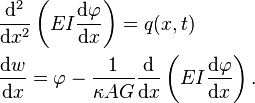






![\delta U = \int_L \int_A (\sigma_{xx}\delta\varepsilon_{xx} + 2\sigma_{xz}\delta\varepsilon_{xz})~\mathrm{d}A~\mathrm{d}L
= \int_L \int_A \left[-z~\sigma_{xx}\frac{\partial (\delta\varphi)}{\partial x} + \sigma_{xz}~\kappa\left(-\delta\varphi + \frac{\partial (\delta w)}{\partial x}\right)\right]~\mathrm{d}A~\mathrm{d}L](../I/m/da7aaaf2e8bd2195c72fec0a1ccddbb1.png)

![\delta U = \int_L \left[-M_{xx}\frac{\partial (\delta\varphi)}{\partial x} + Q_{x}\left(-\delta\varphi + \frac{\partial (\delta w)}{\partial x}\right)\right]~\mathrm{d}L](../I/m/fefdaa1679c2241d6f70ea9e919c0740.png)
![\delta U = \int_L \left[\left(\frac{\partial M_{xx}}{\partial x} - Q_x\right)~\delta\varphi - \frac{\partial Q_{x}}{\partial x}~\delta w\right]~\mathrm{d}L](../I/m/ac66d562743def01b72d517bea033338.png)

![\delta U = \delta W \implies
\int_L \left[\left(\frac{\partial M_{xx}}{\partial x} - Q_x\right)~\delta\varphi - \left(\frac{\partial Q_{x}}{\partial x} + q\right)~\delta w\right]~\mathrm{d}L = 0](../I/m/843257c8d66d016aa16f0df3ec8dfdf5.png)


![\begin{align}
\frac{\partial }{\partial x}\left(EI\frac{\partial \varphi}{\partial x}\right) + \kappa AG~\left(\frac{\partial w}{\partial x}-\varphi\right) & = 0 \\
\frac{\partial }{\partial x}\left[\kappa AG\left(\frac{\partial w}{\partial x} - \varphi\right)\right] + q & = 0
\end{align}](../I/m/ed6cee8c1af34b30f1f6c9fa88a95039.png)
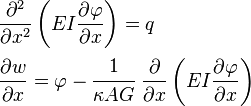








![\rho A\frac{\partial^{2}w}{\partial t^{2}} - q(x,t) = \frac{\partial}{\partial x}\left[ \kappa AG \left(\frac{\partial w}{\partial x}-\varphi\right)\right]](../I/m/94525ef979901dbf2f2601ab3bba4fe7.png)










![\begin{align}
m \frac{\partial^{2}w}{\partial t^{2}} & = \frac{\partial}{\partial x}\left[ \kappa AG \left(\frac{\partial w}{\partial x}-\varphi\right)\right] + q(x,t) \\
J \frac{\partial^{2}\varphi}{\partial t^{2}} & = N(x,t)~\frac{\partial w}{\partial x} + \frac{\partial}{\partial x}\left(EI\frac{\partial \varphi}{\partial x}\right)+\kappa AG\left(\frac{\partial w}{\partial x}-\varphi\right)
\end{align}](../I/m/e795d829b076e2e87476beeba1abc7f0.png)



![m \frac{\partial^{2}w}{\partial t^{2}} + \eta(x)~\cfrac{\partial w}{\partial t} = \frac{\partial}{\partial x}\left[ \kappa AG \left(\frac{\partial w}{\partial x}-\varphi\right)\right] + q(x,t)](../I/m/f9213bee939792a798134a6284fc86d4.png)




